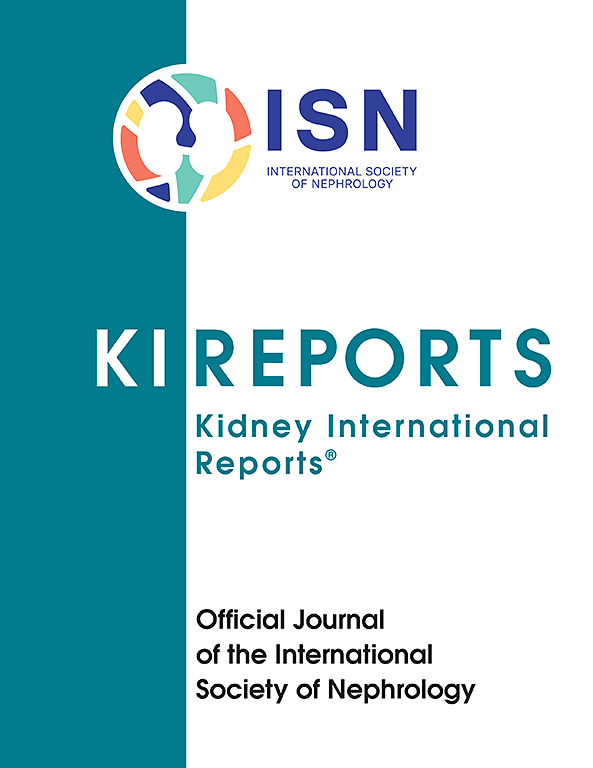Prospective Cohort Study in Alport Syndrome Patients Under Standard Therapy
IF 5.7
2区 医学
Q1 UROLOGY & NEPHROLOGY
引用次数: 0
Abstract
Introduction
Patients with Alport syndrome (AS), a common genetic kidney disease, exhibit variable rates of decline in kidney function. Consequently, this global, multicenter, prospective observational study aimed to generate data useful for designing future interventional trials.
Methods
The study included patients aged 12 to 65 years with a confirmed diagnosis of AS and estimated glomerular filtration rate (eGFR) of 45 to 90 ml/min. For up to 120 weeks in 12-weekly intervals, blood and urine samples, patient and family history, genotype, adverse events (AEs), medications, and patient-related outcome data were collected under International Conference on Harmonization-Good Clinical Practice (ICH-GCP) standards.
Results
Out of 165 patients enrolled, 101 (61.2%) were classified as X-linked (62.4% females, 37.6% males) and 32 (19.4%) as autosomal (recessive or dominant) inheritance. Baseline mean eGFR was 64 ml/min per 1.73 m2, and yearly eGFR slope in ml/min per 1.73 m2 was −2.94 (−6.7 in X-linked males, 0.6 in X-linked females, −1.66 in heterozygous autosomal patients). Baseline urine albumin-to-creatinine ratio (UACR) was the best predictor for rapid loss of eGFR with a yearly eGFR slope of −10.16 ml/min per 1.73 m2 in patients with UACR > 1 g/g compared with−0.90 ml/min per 1.73 m2 if UACR was ≤ 1.0 g/g. Out of 353 AEs, only 26 (7.4%) were related to AS. In addition to UACR, neutrophil gelatinase-associated lipocalin, clusterin, and kidney injury molecule-1 correlated with the eGFR slope.
Conclusion
In patients with AS receiving standard of care, rapid decline in kidney function strongly correlates with UACR and AEs related to the underlying medical condition are rare. Both findings enrich the design of future interventional trials.

标准治疗下Alport综合征患者的前瞻性队列研究
Alport综合征(AS)是一种常见的遗传性肾脏疾病,患者表现出不同程度的肾功能下降。因此,这项全球性、多中心、前瞻性观察性研究旨在为设计未来的干预性试验提供有用的数据。研究对象为年龄12 ~ 65岁,确诊为AS,肾小球滤过率(eGFR)为45 ~ 90ml /min的患者。根据国际协调会议-良好临床实践(ICH-GCP)标准,在长达120周的时间内,以12周为间隔收集血液和尿液样本、患者和家族史、基因型、不良事件(ae)、药物和患者相关结局数据。结果165例患者中,101例(61.2%)为x连锁(女性62.4%,男性37.6%),32例(19.4%)为常染色体(隐性或显性)遗传。基线平均eGFR为64 ml/min / 1.73 m2,年eGFR斜率为- 2.94 (x连锁男性为- 6.7,x连锁女性为0.6,杂合常染色体患者为- 1.66)。基线尿白蛋白与肌酐比值(UACR)是eGFR快速损失的最佳预测指标,在UACR患者中,年eGFR斜率为- 10.16 ml/min / 1.73 m2;如果UACR≤1.0 g/g,则为- 0.90 ml/min / 1.73 m2。353例ae中,仅有26例(7.4%)与AS相关。除了UACR外,中性粒细胞明胶酶相关的脂钙蛋白、聚簇蛋白和肾损伤分子-1也与eGFR斜率相关。结论在接受标准治疗的AS患者中,肾功能的快速下降与UACR和与基础医学条件相关的ae密切相关,这是罕见的。这两个发现丰富了未来干预性试验的设计。
本文章由计算机程序翻译,如有差异,请以英文原文为准。
求助全文
约1分钟内获得全文
求助全文
来源期刊

Kidney International Reports
Medicine-Nephrology
CiteScore
7.70
自引率
3.30%
发文量
1578
审稿时长
8 weeks
期刊介绍:
Kidney International Reports, an official journal of the International Society of Nephrology, is a peer-reviewed, open access journal devoted to the publication of leading research and developments related to kidney disease. With the primary aim of contributing to improved care of patients with kidney disease, the journal will publish original clinical and select translational articles and educational content related to the pathogenesis, evaluation and management of acute and chronic kidney disease, end stage renal disease (including transplantation), acid-base, fluid and electrolyte disturbances and hypertension. Of particular interest are submissions related to clinical trials, epidemiology, systematic reviews (including meta-analyses) and outcomes research. The journal will also provide a platform for wider dissemination of national and regional guidelines as well as consensus meeting reports.
 求助内容:
求助内容: 应助结果提醒方式:
应助结果提醒方式:


